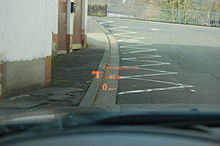Automotive head-up display
Other manufactures such as Audi, BMW, Citroën, Nissan, Mazda, Kia, Mercedes and Volvo currently offer some form of HUD system.
[citation needed] The Eyes-on-the-Road-Benefit (ERB), also known as the Head-Up-Display-Advantage, is the term given to the purported advantages provided to motorists when driving using a head-up display (HUD).
In order to examine HUDs and HDDs, studies often compare hazard reaction time, situational awareness, and quality of driving (such as speed consistency) using both systems.
Saccadic gaze is the perceptual mechanism through which the eye is inadvertently drawn to external stimulus without the individual's conscious action.
[9] These external stimuli can be beneficial in such situations as the movement of a pedestrian about to walk out onto the road, in turn allowing the driver to take evasive action.
Exogenous cues can also be irrelevant, and often dangerous, leading to distraction from goal behaviours, such as the flashing of a cellphone taking one's eyes off the road.
A collaborative project between Faurecia Groupe and Indian Institute of Science developed an eye gaze and finger controlled head up display[11] for cars that can also automatically estimate drivers’ cognitive load and distraction.
There is evidence that as the complexity of driving tasks increases, the benefits of using a HUD are decreased, and in some circumstances, they are no longer statistically significant.
Subsequently, a driver's ability to process HUD feedback requires diversion of attention, much akin to that which occurs whilst using a HDD.
[19] For in-glass laminated HUD, the display glass part is integrated in the windshield while the electronics shall be placed and hidden inside the vehicle body.




